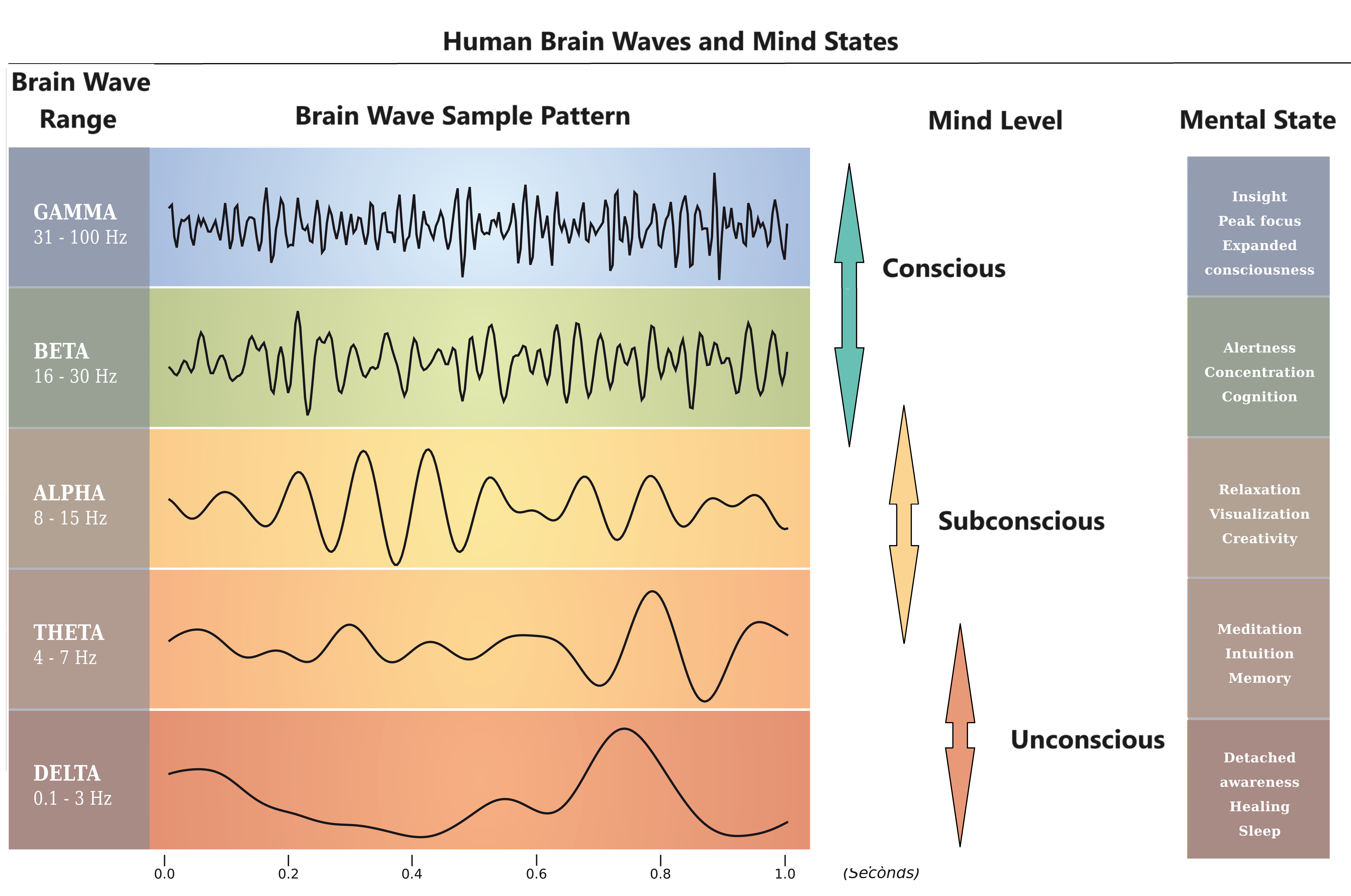Brain Waves and Mental States
Hypnosis and the hypnotic state have been studied for several hundred years. It is a huge topic with many different facets, which in total are well beyond the room we have here. But we can talk about some of the fundamentals. Two fundamental concepts are brain waves, and mind states. But what are these and how do they relate to our personality?
The human brain is very active electrically. The brain's level of activity can be measured and categorized in terms of electric waves, also known as brain waves. Brain waves, in turn, correspond to different mental states, ranging from almost no activity at all, to extremely active, as illustrated below.

These mind states are important, because they correspond to a person's conscious, subconscious and unconscious states:
- Gamma waves correspond to a hyper-aware mental state of intense focus and/or multitasking. This is a state that most adults would find tiring after short periods, and this level of brain functioning cannot be sustained for extended periods of time.
- Beta waves correspond to what adults would consider normal "awake" state, and features a combination of calm alertness and responses, normal motor control, and normal access to memories.
- Alpha waves correspond to a state of relaxation, creativity and passive yet detailed observation. It is the state that children spend most of their waking moments in, and is characterized by very high levels of sensory input and absorption. In other words, it is a state of learning. It is also where the conscious mind starts to yield to the subconscious mind. The lower range of the alpha state is where a person's mind is when that person daydreams.
- Theta waves correspond to increased relaxation, the loss of consciousness and REM sleep. This is the core of subconscious mind, and a person's best access to creativity, imagination, intuition, and memory. Both meditation and hypnosis practices deliberately bring a person to deep alpha or light theta states. However, each individual passes through this theta state whenever falling asleep and waking up.
- Delta waves correspond to unconsciousness. The mind is in deep dreamless sleep, and the body engages in restorative and healing activities.
Notice that the various levels of consciousness overlap with each other. This means that there are two areas where these ranges can be accessed simultaneously:
- When the conscious and subconscious overlap, we can retain conscious thoughts while also becoming aware of subconscious beliefs, values, identities, memories and intuitions. This overlap area is where hypnosis begins. This would be considered a "light" hypnotic state. Going further into the alpha state towards the theta state, also "deepens" the hypnosis. This means the conscious mind has less and less influence over what the person perceives during the hypnotic session.
- When the subconscious and unconscious overlap, the person is in the deepest possible hypnotic state. If the hypnotic state deepens further, the person's mind enters an unconscious state, and any further therapeutic benefit ends. As far as we know, the mind is no longer accessible as it enters unconsciousness and begins bodily maintenance. Hypnotherapists work to keep the person above this point.
Interestingly, medical hypnosis makes use of these two overlaps. When a person needs medical hypnotic anesthesia, the hypnotherapist will carefully create and maintain exactly the right level of hypnotic "depth" to provide just the right amount of conscious awareness vs anesthetic numbness. This is possibly the most demanding level of hypnotic expertise amongst hypnotic practitioners, needing a great deal of training. However, medical research has firmly established the value of medical anesthetic hypnosis where chemical anesthesia cannot be used for various reasons. While medical hypnotherapy is beyond the scope of this website, check out this fascinating research article about medical and dental hypnotherapy from the National Institutes of Health.
NOTE: Medical anesthesia hypnosis is outside of my area of expertise. However, if you are either a health provider or a patient, and you need to find a medical or dental anesthetic hypnotherapist, contact me and I can refer you to qualified specialists.
In summary, daily life is full of situations where we naturally and easily slide in and out of these various states, as our activity levels and mental concentration levels change. Hypnosis is nothing more, and nothing less, than the deliberate act of putting ourselves into an alpha state, so that we have access to both the conscious and subconscious levels of the mind. Whether we learn self-hypnosis, or work with a hypnotherapist, we can reap the rewards of having access to all the mental states, as often as we need that access to make beneficial changes.
|
Shopping Cart |
|
Contact Me For Help Reaching Your Goals

When you're ready to move forward, push through obstacles and make real progress towards your goals, Contact Me today.
New Products and Services Request Form
Do you have a product or service request that you don't already see listed here? I'd love to hear your ideas! Please feel free to either Contact Me or fill out my new Product and Service Request Form.
Thanks for your suggestions!
